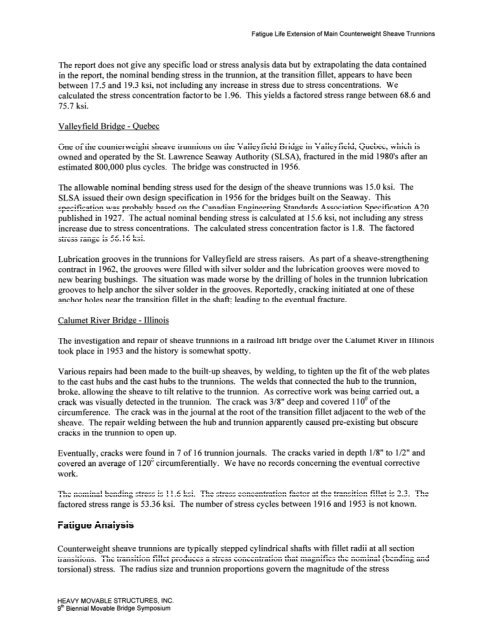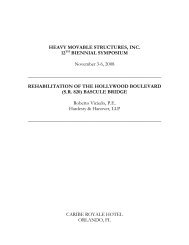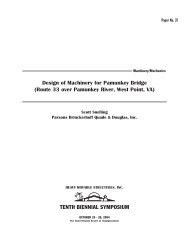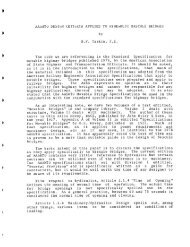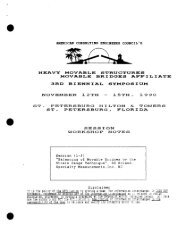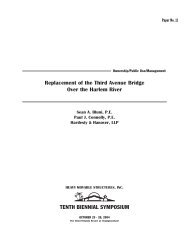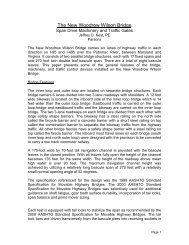Fatigue of Counterweight Sheave Trunnions - Heavy Movable ...
Fatigue of Counterweight Sheave Trunnions - Heavy Movable ...
Fatigue of Counterweight Sheave Trunnions - Heavy Movable ...
You also want an ePaper? Increase the reach of your titles
YUMPU automatically turns print PDFs into web optimized ePapers that Google loves.
<strong>Fatigue</strong> Life Extension <strong>of</strong> Main <strong>Counterweight</strong> <strong>Sheave</strong> <strong>Trunnions</strong><br />
The report does not give any specific load or stress analysis data but by extrapolating the data contained<br />
in the report, the nominal bending stress in the trunnion, at the transition fillet, appears to have been<br />
between 17.5 and 19.3 ksi, not including any increase in stress due to stress concentrations. We<br />
calculated the stress concentration factorto be 1.96. This yields a factored stress range between 68.6 and<br />
75.7 ksi.<br />
Valleyfield Bridne - Quebec<br />
One <strong>of</strong> the counterweight sheave trunnions on the Valleyfield Bridge in Valleyfield, Quebec, which is<br />
owned and operated by the St. Lawrence Seaway Authority (SLSA), fractured in the mid 1980's after an<br />
estimated 800,000 plus cycles. The bridge was constructed in 1956.<br />
The allowable nominal bending stress used for the design <strong>of</strong> the sheave trunnions was 15.0 ksi. The<br />
SLSA issued their own design specification in 1956 for the bridges built on the Seaway. This<br />
specification was probably based on the Canadian Engineering Standards Association Specification A20<br />
published in 1927. The actual nominal bending stress is calculated at 15.6 ksi, not including any stress<br />
increase due to stress concentrations. The calculated stress concentration factor is 1.8. The factored<br />
stress range is 56.16 ksi.<br />
Lubrication grooves in the trunnions for Valleyfield are stress raisers. As part <strong>of</strong> a sheave-strengthening<br />
contract in 1962, the grooves were filled with silver solder and the lubrication grooves were moved to<br />
new bearing bushings. The situation was made worse by the drilling <strong>of</strong> holes in the trunnion lubrication<br />
grooves to help anchor the silver solder in the grooves. Reportedly, cracking initiated at one <strong>of</strong> these<br />
anchor holes near the transition fillet in the shaft; leading to the eventual fracture.<br />
Calumet River Bridne - Illinois<br />
The investigation and repair <strong>of</strong> sheave trunnions in a railroad lift bridge over the Calumet River in Illinois<br />
took place in 1953 and the history is somewhat spotty.<br />
Various repairs had been made to the built-up sheaves, by welding, to tighten up the fit <strong>of</strong> the web plates<br />
to the cast hubs and the cast hubs to the trunnions. The welds that connected the hub to the trunnion,<br />
broke, allowi~lg the sheave to tilt relative to the trunnion. As corrective work was being carried out, a<br />
crack was visually detected in the trunnion. The crack was 318" deep and covered 1 10' <strong>of</strong> the<br />
circumference. The crack was in the journal at the root <strong>of</strong> the transition fillet adjacent to the web <strong>of</strong> the<br />
sheave. The repair welding between the hub and trunnion apparently caused pre-existing but obscure<br />
cracks in the trunnion to open up.<br />
Eventually, cracks were found in 7 <strong>of</strong> 16 trunnion journals. The cracks varied in depth 118" to 112" and<br />
covered an average <strong>of</strong> 120' circumferentially. We have no records concerning the eventual corrective<br />
work.<br />
The nominal bending stress is 11.6 ksi. The stress concentration factor at the transition fillet is 2.3. The<br />
factored stress range is 53.36 ksi. The number <strong>of</strong> stress cycles between 191 6 and 1953 is not known.<br />
<strong>Fatigue</strong> Analysis<br />
<strong>Counterweight</strong> sheave trunnions are typically stepped cylindrical shafts with fillet radii at all section<br />
transitions. The transition fillet produces a stress concentration that magnifies the nominal (bending and<br />
torsional) stress. The radius size and trunnion proportions govern the magnitude <strong>of</strong> the stress<br />
HEAVY MOVABLE STRUCTURES, INC.<br />
gth Biennial <strong>Movable</strong> Bridge Symposium


